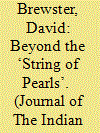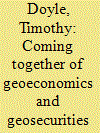| Srl | Item |
| 1 |
ID:
134299


|
|
|
|
|
| Summary/Abstract |
The article will ask whether Sino-Indian strategic competition in the Indian Ocean should be properly understood through the lens of a security dilemma. It examines the strategic positions of India and China in the Indian Ocean and concludes that India has an overwhelming strategic advantage that China cannot realistically mitigate in the foreseeable future. This advantage precludes any real security dilemma arising between them. In fact, both China and India have good reasons to keep strategic competition under control while they each broaden their regional influence.
|
|
|
|
|
|
|
|
|
|
|
|
|
|
|
|
| 2 |
ID:
134302


|
|
|
|
|
| Summary/Abstract |
Up to the abrogation of the Simon's Town Agreement in 1975, the South African Navy acquired the bulk of its equipment from Britain. Efforts to purchase corvettes and submarines from Portugal and France were cancelled during the 1970s as a result of the pariah status of apartheid South Africa. An indigenous naval shipbuilding industry developed in South Africa and succeeded in the building six Israeli-designed missile strike craft under licence and a locally designed replenishment vessel (the SAS Drakensberg) amongst others. After the end of apartheid South Africa purchased frigates and submarines from Germany, while on-board installation and integration of weapon systems and sensors were done in South Africa in cooperation with local and international armaments companies. As South Africa retains a small commercial shipbuilding industry it is anticipated that some of the naval vessels the South African Navy would require in future might be channelled to local shipyards.
|
|
|
|
|
|
|
|
|
|
|
|
|
|
|
|
| 3 |
ID:
134283


|
|
|
| 4 |
ID:
134303


|
|
|
|
|
| Summary/Abstract |
Scholarly work on maritime peacekeeping and responses to maritime insecurity increased notably in the early twenty-first century with much attention turning to Africa's maritime landscape. Africa's offshore security governance became particularly salient as a result of threats to good order at sea as well as how actors in the international system responded. One way of describing the responses to Africa's maritime domain is to view it as part of the response continuum depicting conflict prevention and conflict resolution. Security arrangements at sea depict a growing recognition of the importance of Africa's oceans to the extent that the landward focus of many leaders and security actors has gained a parallel domain – that of maritime security. Thrust upon the wider African security agenda by piracy off East Africa, the importance of the African maritime landscape dawned not only upon the international community and the UN in particular, but the African leadership as well. Threats at sea around Africa have an umbilical connection to what transpires on land and are equally complex to deal with. In a certain way, as suggested in this piece, reactions to promote maritime security governance off eastern Africa have become part of the wider conflict resolution agendas of actors as displayed off the Horn of Africa and in waters of the Southern African Development Community (SADC) further to the south.
|
|
|
|
|
|
|
|
|
|
|
|
|
|
|
|
| 5 |
ID:
134305


|
|
|
|
|
| Summary/Abstract |
Observations of Australia and India as committed partners in a shared venture during the Prime Ministerships of Malcolm Fraser, Morarji Desai and Indira Gandhi reveal a rare period of close collaboration at prime ministerial and senior government levels. The prime ministerial triumvirate's Commonwealth Heads of Government Regional Meetings (CHOGRMs) grew out of annual Officials' Talks and are not replicated in today's plethora of regional groupings. They are, however, a glimpse of a successful Commonwealth endeavour led by Australia and India, disbanded after Fraser lost government.
|
|
|
|
|
|
|
|
|
|
|
|
|
|
|
|
| 6 |
ID:
134304


|
|
|
|
|
| Summary/Abstract |
The African Khōjā are an Indic Muslim caste, which began migrating from Sindh and Gujarat to East Africa in the late eighteenth century. During the nineteenth and twentieth centuries, their economic success in an institutionally underdeveloped region coupled with a strong religious impetus allowed them to build communal municipal institutions throughout the region that both mimicked and replaced the absent state. The insecurity of postcolonial East Africa, such as the 1964 revolution in Zanzibar and the 1972 Ugandan Asian exodus, forced the Khōjā to further expand their bureaucratic apparatus towards foreign policy-migration to Western Europe and North America and requisite institutionalisation. In the twenty-first century, the Khōjā coordinate these communal networks from North America and Western Europe to Asia and Africa towards a religious-based economic development in emerging economies. Their primary identity is religious, defined from within and outwith, using the mechanisms of globalisation to further communal aims internationally within a framework of religious nationalism insensible to state nationalism.
|
|
|
|
|
|
|
|
|
|
|
|
|
|
|
|
| 7 |
ID:
134300


|
|
|
|
|
| Summary/Abstract |
This article details the importance of non-traditional security (NTS) issues as catalysts for the development and expansion of regional security architectures across the Indo-Pacific. The trans-boundary and non-military character of NTS issues, such as natural disasters and pandemic disease, have compelled states across the region to seek deeper and more substantial levels of security integration. NTS issues have pushed existing security structures west into the Indian Ocean and initiated the development of newer defence-based regional forums. New cooperative structures include large multi-lateral groupings such as the ASEAN Regional Forum and the ASEAN Defence Ministers' Meeting as well as bi-lateral agreements between ASEAN and other countries in the Indo-Pacific. Largely based on NTS issues, these venues firmly stretch ASEAN-based coordination across the Indo-Pacific and demonstrate an unprecedented move towards cooperative security. NTS issues provide important opportunities and incentives for security cooperation across the Indo-Pacific and should be perceived as valuable first steps toward more coherent and integrated Indo-Pacific security architectures.
|
|
|
|
|
|
|
|
|
|
|
|
|
|
|
|
| 8 |
ID:
134301


|
|
|
|
|
| Summary/Abstract |
Unmanned Aerial Vehicles (UAVs), or drones, have undoubtedly attained a prominent position in contemporary and future defence technologies. Likewise, Asian militaries have continued to realise the operational value of such vehicles, whether for Intelligence, Surveillance, and Reconnaissance (ISR) or combat purpose. In the current times, wherein UAVs are proliferating globally, it remains pivotal to understand their relevance, uses and implications, particularly with regard to emerging powers. It is in this context that the paper seeks to explore and compare the cases of the two rising Asian giants, India and China. The paper explores their UAV programmes, possible defence-oriented employments, and current technological capabilities to produce UAVs. The relevance of UAVs is assessed in terms of India and China's present military doctrines, security requirements (current and future) and how the UAVs fit into their security landscape. Finally, the article delves into the strategic implications of the greater proliferation and rampant employment of UAVs in the region.
|
|
|
|
|
|
|
|
|
|
|
|
|
|
|
|